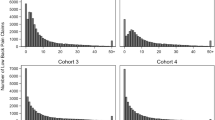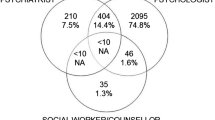Abstract
Objectives To describe the incidence, duration, and patterns of working time loss claims in compensated Australian workers with low back pain (LBP), and compare this with limb fracture (LF) and non-specific limb condition (NSLC) claims. Methods The National Dataset for Compensation-based Statistics was used for this study. Accepted workers’ compensation time loss claims for LBP, LF or NSLC occurring between July 2010 and June 2015 were included. Counts, rates per 10,000 covered workers, the relative risk and median duration of time loss were calculated. Multivariate Cox and quantile regression models were used to determine factors affecting time loss duration and patterns. Results There were 56,102 LBP claims, 42,957 LF claims, and 18,249 NSLC claims. The relative risk of a claim for LBP was significantly greater than LF after adjustment for all covariates (ARR 1.30, 95% CI 1.29–1.32, p < 0.001). LBP claims had similar median time loss (9.39 weeks) to LF claims (9.21 weeks). Claims for LBP were significantly more likely to be resolved in the early phase (10th and 25th quantiles of time loss; 25th quantile: − 1.12 weeks, 95% CI − 1.20 to − 1.05) than claims for LF, but significantly less likely to be resolved in the later phase (75th and 90th quantiles; 75th quantile: 7.02 weeks, 95% CI 6.42–7.61). Claims for NSLC had generally greater time loss than claims for LF, but less time loss than LBP above the 90th quantile. Conclusions The risk of a claim for LBP is higher than LF and NSLC. Although LBP claims are more likely to resolve in the early phase than limb fracture and NSLC claims, LBP claims have longer durations when workers are away from work more than seven weeks.


Similar content being viewed by others
References
Australian Institute of Health and Welfare (AIHW). Australian Burden of Disease Study: impact and causes of illness and death in Australia 2015. Canberra: AIHW; 2019.
GBD 2017 Disease and Injury Incidence and Prevalence Collaborators. Global, regional, and national incidence, prevalence, and years lived with disability for 354 diseases and injuries for 195 countries and territories, 1990–2017: a systematic analysis for the Global Burden of Disease Study 2017. Lancet. 2018;392(10159):1789–858.
Hartvigsen J, Hancock MJ, Kongsted A, Louw Q, Ferreira ML, Genevay S, et al. What low back pain is and why we need to pay attention. Lancet. 2018;391(10137):2356–67.
Foster NE, Anema JR, Cherkin D, Chou R, Cohen SP, Gross DP, et al. Prevention and treatment of low back pain: evidence, challenges, and promising directions. Lancet. 2018;391(10137):2368–83.
Australian Institute of Health and Welfare (AIHW). Back problems: what role do GPs play in treating back problems? Canberra: AIHW; 2017 https://www.aihw.gov.au/reports/arthritis-other-musculoskeletal-conditions/back-problems/what-role-do-gps-play-in-treating-back-problems.
Dunn KM, Hestbaek L, Cassidy JD. Low back pain across the life course. Best Pract Res Clin Rheumatol. 2013;27(5):591–600.
Froud R, Patterson S, Eldridge S, Seale C, Pincus T, Rajendran D, et al. A systematic review and meta-synthesis of the impact of low back pain on people's lives. BMC Musculoskelet Disord. 2014;15:50.
Anema JR, Schellart AJM, Cassidy JD, Loisel P, Veerman TJ, Van Der Beek AJ. Can cross country differences in return-to-work after chronic occupational back pain be explained? An exploratory analysis on disability policies in a six country cohort study. J Occup Rehabil. 2009;19(4):419–26.
Collie A, Di Donato M, Iles R. Work disability in Australia: an overview of prevalence, expenditure, support systems and services. J Occup Rehabil. 2018;29(3):526–39.
Australia SW. Comparison of workers' compensation arrangements in Australian and New Zealand 2017. Canberra: SWA; 2017. p. 2017.
Lane TJ, Collie A, Hassani-Mahmooei B. Work-related injury and illness in Australia, 2004 to 2014. What is the incidence of work-related conditions and their impact on time lost from work by state and territory, age, gender and injury type?. Melbourne: ISCRR; 2016.
Safe Work Australia. Australian workers' compensation statistics. Canberra: Safe Work Australia; 2018.
Shraim M, Cifuentes M, Willetts JL, Marucci-Wellman HR, Pransky G. Length of disability and medical costs in low back pain: do state workers' compensation policies make a difference? J Occup Environ Med. 2015;57(12):1275–83.
Steenstra IA, Busse JW, Tolusso D, Davilmar A, Lee H, Furlan AD, et al. Predicting time on prolonged benefits for injured workers with acute back pain. J Occup Rehabil. 2015;25(2):267–78.
Steenstra IA, Munhall C, Irvin E, Oranye N, Passmore S, Van Eerd D, et al. Systematic review of prognostic factors for return to work in workers with sub acute and chronic low back pain. J Occup Rehabil. 2017;27(3):369–81.
Safe Work Australia. National data set for compensation-based statistics, third edition, revision 1. Canberra: Safe Work Australia; 2004.
International Labour Organization (ILO). World Social Protection Report 2017–19 - Universal social protection to achieve the Sustainable Development Goals. Geneva, Switzerland: ILO; 2017 14 May 2018. Contract No.: ISBN 978-92-2-130016-8.
Lippel K, Lötters F. Public insurance systems: a comparison of cause-based and disability-based income support systems. In: Loisel P, Anema JR, editors. Handbook of work disability: prevention and management. New York: Springer; 2013. p. 183–202.
Gray SE, Collie A. The nature and burden of occupational injury among first responder occupations: a retrospective cohort study in Australian workers. Injury. 2017;48(11):2470–7.
Gray SE, Collie A. Comparing time off work after work-related mental health conditions across Australian workers’ compensation systems: a retrospective cohort study. Psychiatry Psychol Law. 2018;25(5):675–92.
Safety A, Council C. Type of Occurrence Classification System (Third edition, revision one). Canberra: ASCC; 2008.
McRae R, Esser M. Practical fracture treatment. 5th ed. New York: Churchill Livingstone; 2008.
National Institute for Health and Care Excellence. Fractures (non-complex): assessment and management. NICE Guideline NG38. London: NICE; 2016.
National Institute for Health and Care Excellence. Low back pain and sciatica in over 16s: assessment and management. London: NICE; 2016.
Young AE, Wasiak R, Phillips L, Gross DP. Workers' perspectives on low back pain recurrence: "it comes and goes and comes and goes, but it's always there". Pain. 2011;152(1):204–11.
Collie A, Lane TJ, Hassani-Mahmooei B, Thompson J, McLeod C. Does time off work after injury vary by jurisdiction? A comparative study of eight Australian workers' compensation systems. BMJ Open. 2016;6(5):e010910.
Australian Bureau of Statistics. Australian and New Zealand standard classification of occupations, 2013, Version 12. Canberra: Australian Bureau of Statistics; 2013.
Australian Bureau of Statistics. 2006 RA from 2006 POA Correspondence. Australian standard geographical classification (ASGC) remoteness area correspondences. Canberra: Australian Bureau of Statistics; 2011.
Australian Bureau of Statistics (ABS). Postal Area, Indexes, SEIFA 2011. Census of Population and Housing: Socio-Economic Indexes for Areas (SEIFA), Australia, 2011. Canberra: Australian Bureau of Statistics; 2013.
Department of Health and Aged Care. Measuring remoteness: accessibility/remoteness index of Australia (ARIA) revised edition. Occasional papers: new series number 14. Canberra: Department of Health and Aged Care; 2001.
van Buuren S, Groothuis-Oudshoorn G, Robitzsch A, Vink G, Doove L, Jolani S, et al. mice: multivariate imputation by chained equations. R package version 3.5.0; 2019.
Bellera CA, MacGrogan G, Debled M, de Lara CT, Brouste V, Mathoulin-Pélissier S. Variables with time-varying effects and the Cox model: some statistical concepts illustrated with a prognostic factor study in breast cancer. BMC Med Res Methodol. 2010;10(1):20.
Webb P, Bain C, Page A. Essential epidemiology: an introduction for students and health professionals. 3rd ed. Cambridge: Springer; 2017.
Koenker R. Quantile regression: 40 years on. Annu Rev Econ. 2017;9(1):155–76.
Koenker R, Hallock KF. Quantile regression. J Econ Perspect. 2001;15(4):143–56.
Fan ZJ, Foley MP, Rauser E, Bonauto DK, Silverstein BA. Effects of residential location and work-commuting on long-term work disability. J Occup Rehabil. 2013;23(4):610–20.
R Core Team. R: a language and environment for statistical computing. Vienna: R Foundation for Statistical Computing; 2017.
Corporation M. Microsoft visual studio 2017. Redmond: Microsoft Corporation; 2018.
Gray SE, Lane TJ, Sheehan L, Collie A. Association between workers' compensation claim processing times and work disability duration: analysis of population level claims data. Health Policy. 2019;123(10):982–91.
Macpherson RA, Lane TJ, Collie A, McLeod CB. Age, sex, and the changing disability burden of compensated work-related musculoskeletal disorders in Canada and Australia. BMC Public Health. 2018;18(1):758.
Kwon BK, Roffey DM, Bishop PB, Dagenais S, Wai EK. Systematic review: occupational physical activity and low back pain. Occup Med. 2011;61(8):541–8.
Lane TJ, Gray S, Hassani-Mahmooei B, Collie A. Effectiveness of employer financial incentives in reducing time to report worker injury: an interrupted time series study of two Australian workers’ compensation jurisdictions. BMC Public Health. 2018;18(1):100.
Lane TJ, Gray SE, Sheehan L, Collie A. Increased benefit generosity and the impact on workers' compensation claiming behavior: an interrupted time series study in Victoria, Australia. J Occup Environ Med. 2019;61(3):e82–e90.
Acknowledgements
This paper uses data supplied by Safe Work Australia and has been compiled in collaboration with state, territory and Commonwealth workers' compensation regulators. The views expressed are the responsibility of the author(s) and are not necessarily the views of Safe Work Australia or the state, territory and Commonwealth workers' compensation regulators.
Funding
Mr Di Donato receives a Research Training Program (RTP) Scholarship Stipend from the Australian Government. Professor Buchbinder is supported by an Australian National Health and Medical Research Council (NHMRC) Senior Principal Research Fellowship (APP 1082138). Professor Collie is supported by an Australian Research Council (ARC) Discovery Project Grant (DP190102473) and Future Fellowship (FT190100218).
Author information
Authors and Affiliations
Corresponding author
Ethics declarations
Conflict of interests
The authors declare no competing interests.
Additional information
Publisher's Note
Springer Nature remains neutral with regard to jurisdictional claims in published maps and institutional affiliations.
Electronic supplementary material
Below is the link to the electronic supplementary material.
Rights and permissions
About this article
Cite this article
Di Donato, M., Buchbinder, R., Iles, R. et al. Comparison of Compensated Low Back Pain Claims Experience in Australia with Limb Fracture and Non-Specific Limb Condition Claims: A Retrospective Cohort Study. J Occup Rehabil 31, 175–184 (2021). https://doi.org/10.1007/s10926-020-09906-x
Published:
Issue Date:
DOI: https://doi.org/10.1007/s10926-020-09906-x




